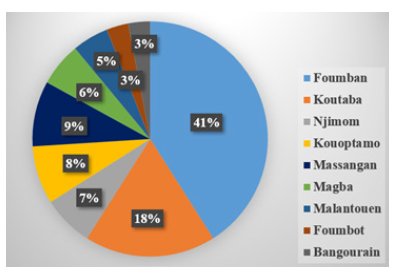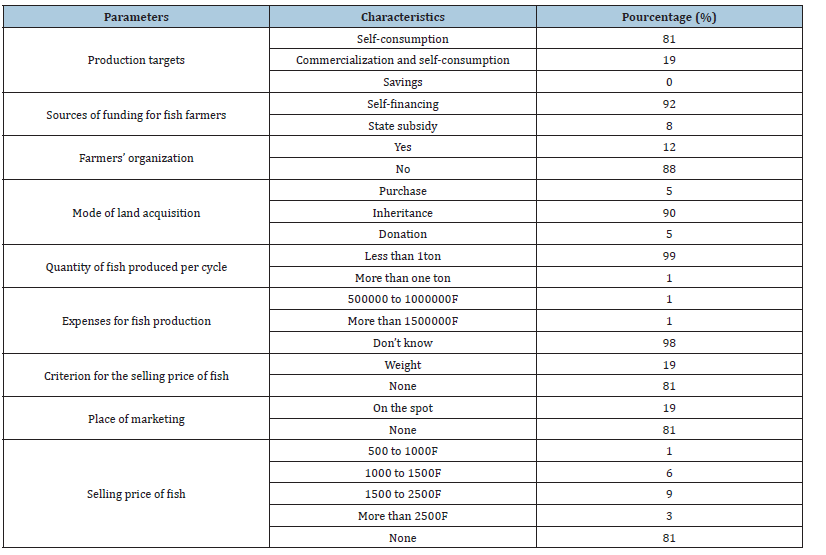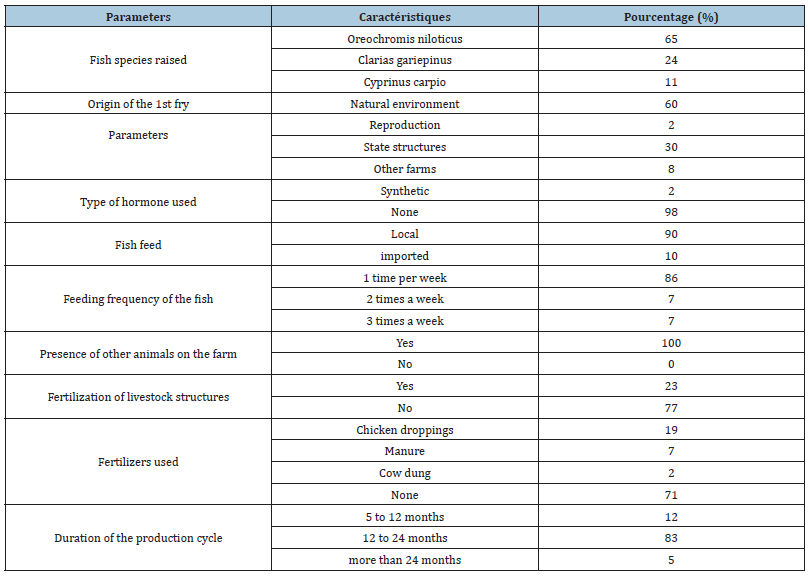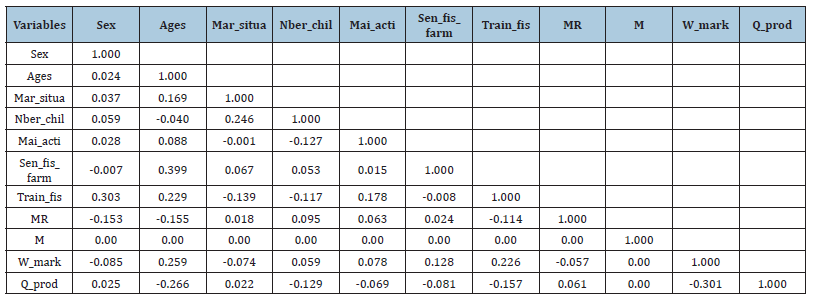- Submissions

Full Text
Clinical Research in Animal Science
Socio-Economic and Zootechnical Characterization of Fish Farming in the Noun Division (West Region-Cameroon)
David Fokom Wauffo1,2, Emile Miégoué2*, Marie Noël Bertine Noumbissi2, Cédric Kwayep Nyah2, France Gina Djoumessi Tobou2, Brice Hermann Fokouong Tcholong1, Fernand Tendonkeng2
1Multipurpose Research Station, Institute of Agricultural Research for Development, Cameroon
1Department of Animal Science, Faculty of Agronomy and Agricultural Sciences, Cameroon
*Corresponding author:Emile Miégoué, Department of Animal Science, Faculty of Agronomy and Agricultural Sciences, University of Dschang, Cameroon, P.O. Box: 188, Dschang-Cameroon
Submission: September 14, 2023;Published: October 16, 2023

ISSN: 2770-6729Volume 3 - Issue 2
Abstract
The purpose of this study was to provide preliminary information on fish farming in Noun Division in order to contribute to the improvement of fish production and productivity. The Accelerated Participatory Research Method (APRM) and snowball approach were adopted. The data were analyzed using descriptive statistics and Principal Component Analysis (PCA). The study revealed that fish farming is practiced in all the subdivisions of Noun Division. This activity is dominated by men (94%), polygamists (86%), over 60 years of age (55%) and with a primary education level (75%). The fish raised are mainly intended for self-consumption (81%) and self-financing (92%) is the main source of financing for this type of farming. Production costs are unknown to 98% of the farmers. Almost all fish farmers practice the extensive farming system (96%) with family labor (74%) being the most used. The common practice in this type of farming is monoculture (63%) with Oriochromis niloticus (65%) in ponds and not fertilized (71%). Local feed is used by 90% of these farmers. Age, fish farming education, marketing location and source of funding are the main socio-economic characteristics most correlated with fish farm performance indicators. Age is negatively correlated with production quantity, while source of finance is not. The development of fish farming in Noun Division will therefore require the implementation of participatory strategies with the farmers that will allow the government to promote fish farming and strengthen the extension services for this activity.
Keywords:Fish farming; Characterization; Farming techniques; Noun division
Introduction
Fishery products are considered as the main sources of animal protein in the world as they constitute 44% of total animal protein intake [1]. Fish also plays an essential role in the food security and well-being of the world’s populations in general and Cameroon’s in particular (Toppe et al., and FAO [1]). Indeed, 89% of fisheries production in Cameroon is for human consumption and the remaining 11% for non-food uses (mainly fish meal and fish oil production) (FAO, 2019). However, the increasing rise in the population of fishermen, the multiplication and sophistication of gear and catching methods have caused a decline in global fisheries production [2]. To address this shortfall, fish farming has been strongly developed in recent decades in African countries through programs such as the Project for the Development of Fish Farming in the Central and Eastern Regions of Cameroon (PDPCE) and the Extensive Family Fish Farming Systems in West and Central Africa (SyPiEx) project, set up to boost fish farming production. However, several constraints have been identified as impediments to fish farming in these countries, including institutional, financial, technical and organizational levels [3-6]. They negatively influence the practice of this activity [7], which leads to the reduction of production, resulting in low productivity and profitability of fish farms [8]. Thus, in an effort to define different strategies for improving fish farming productivity in Cameroon, many studies have focused on the socio-economic and technical characterization of fish farms in different regions of Cameroon, such as the work of Tiogué TC [9] in Mbam and Inoubou, Bomba [10] in Mfoundi, Atangana et al. [11] in the East region, Oben et al. [12] in the North-West and South-West regions. In the Noun Division, on the other hand, very few studies are available on this subject. It is within this framework that a descriptive survey of fish farming in this Division was initiated, with the objective of contributing to the improvement of knowledge on aquaculture production through the evaluation of socio-economic and zootechnical parameters of fish farming.
Materials and Methods
Study area
The study took place from February to May 2021 in the Noun Division; West Region of Cameroon, located between longitudes 10°30 and 11°40 East and latitude 5° and 6° North. It has 9 subdivisions (Foumban, Koutaba, Foumbot, Kouoptamo, Massangam, Malantouen, Njimom, Magba, Bangourain) and covers an area of 13892km2.
Data collection
Data collection for this study followed the Accelerated Participatory Research Method (APRM) [13,14]. Focus groups were organized through focal persons such as village chiefs and heads of zootechnical and veterinary centers in the Subdivision, in order to ensure institutional anchoring. Herders were identified using a non-probability method known as “snowballing” [15]. In this method, the first farmers surveyed inform on other fish farmers and thus become additional informants. The sampling strategy used was exhaustive across the nine Sub-divisions in Noun divisions. The semi-structured surveys based on the survey forms made it possible to obtain reliable information on the identification and location of the farms, as well as their socio-economic and zootechnical characteristics. The identification of the breeding areas was done with the help of an agent from the divisional delegation of livestock breeding, fishering and animal industries. This survey was preceded by a pre-survey that allowed us to determine the sample size, target the farmers to be surveyed and validate the interview guide used during this work Fish.
Data processing and analysis
The collected data were encoded in the Excel software version
2016. Descriptive statistics were used to determine the percentages
of the different information collected in the field. Differential
statistics were performed using SPSS software (Version 21.0).
A. The Kolmogorov-smirnov and shapiro-wilk tests were
used to test the normality of the variables of the socio-economic
and zootechnical characteristics of the fish farmers.
B. Principal Component Analysis (PCA) was used to establish
the correlation between the different variables in order to retain
only the most explanatory variables of the characteristics of the
producers.
Result
Distribution of fish farmers in noun division
Fish farming is currently practiced in all the subdivisions of the Noun division (Figure 1). The Foumban subdivision has the largest number of fish farmers (41%) followed by the Koutaba subdivision (18%), Massangam (9%), Kouoptamo (8%), Njimom (7%), Magba (6%) and Malantouen (5%). In addition, the Foumbot subdivision and Bangourain (3%) appear to be the areas where fish farming is least practiced.
Figure 1:Distribution of fish farmers according to the different subdivisions.

Social characterization of fish farming actors in noun division
Table 1 shows that fish farming in the Noun Division is mostly carried out by men (94%), married and polygamous (86%), over 60 years old (55%) with more than 15 years of experience in fish farming (41%), and most of them have a primary education (75%). Approximately 37% of the farmers take care of a number of children between 5 and 10. The main activity of these fish farmers remains agriculture (66%) while traders, active employees and retired employees represent respectively (17%), (14%) and (3%).
Table 1:Distribution of fish farmers according to social characteristics.

Economic characterization of fish farming in noun division
This study shows that the fish produced are mainly intended for self-consumption (81%) (Table 2). The achievement of the production objectives is faced with low subsidies from the State, national and international partners (8%). In fact, self-financing (92%) represents the main source of financing for fish farmers. In addition, only 12% of respondents are members of a formal farmer organization. Overall, these farmers acquire their land through inheritance (90%), producing less than one ton of fish (99%) per production cycle in this space. The farmers do not control their production costs (98%), which means that the selling price of the fish is generally not based on any criteria (81%). In addition, 81% of the fish farmers do not have a place to market the fish and therefore have no control over the selling price.
Table 2:Distribution of fish farmers according to economic characteristics.

Technical characterization of fish farms in noun division
The distribution of fish farmers according to the type of labor shows that whatever the group, family labor (74%) is the most used in this farm (Table 3). In addition, 70% of the fish farmers have not received any technical training to run this farm and these fish farmers would like to receive training in the future to become professional and expand their farms. With regard to biosecurity, all of the respondents (100%) do not have foot baths and the presence of other animal species is noted in all farms. The majority of the interviewees do not practice a sanitary vacuum (97%) and all the farmers (100%) do not analyze the quality of the water that feeds their structures. We noted that the majority of fish farmers practice the extensive farming system (96%), while the integrated and intensive systems represent the same proportions (2%). With regard to the type of integrated system, hen-fish and pigeon-fish represent the same proportion (1%). Fish farming facilities in this division are dominated by ponds (96%), followed by concrete tanks (2%) and combinations of ponds and concrete tanks (2%). In addition, the type of farming is dominated by monoculture (87%). Overall, these farms do not record their farm data in a farm register.
Table 3:Distribution of fish farmers according to farming techniques.

Zootechnical characteristics of fish farming in Noun division
As shown in Table 4, Tilapia (Oreochromis niloticus) is the main species raised by farmers in Noun division (65%), followed by catfish (Clarias gariepinus) (24%) and carp (Cyprinus carpio) (11%). The majority of the fry used for growth in these farms come from the natural environment (60%). 98% of the fish farmers do not use synthetic or even natural hormones in the reproduction process on their farms. Fish feeding is based mainly on local feed (90%) with a feeding frequency of once a week (86%). In addition to fish, the respondents keep other animals on their farms. It can be seen that the largest number of producers (77%) do not fertilize the ponds, while 23% do, and the most common fertilizer used is chicken droppings. 83% of the fish farmers raise their fish for a period of between 12 and 24 months.
Table 4:Distribution of fish farmers according to zootechnical characteristics.

Correlations between Social characteristics and some production performance indicators
Table 5 of the correlations from the PCA shows that gender, age and training in fish farming are negatively and non-significantly correlated with fish mortality rate. Market weight, age, length of time in farming and training in fish farming are positively correlated. The quantity of fish produced, age, number of children and training in fish farming are negatively correlated and only age is significant. The annual contribution of fish farming, age, marital status, and fish farming education are positively correlated while gender and main activity are not significantly different
Table 5:Distribution of fish farmers according to zootechnical characteristics.

Legend: Mar_situa: Marital Status; Nber_chil: Number of Children; Mai_acti: Main Activity; Sen_fis_farm: Seniority in Fish Farming; Train_fis: Training in Fish Farming; MR: Mortality Rate; M: Disease; W_mark: Weight of the Fish at the Time of Marketing; Q_prod: Quantity of Fish Produced.
Correlation of economic characteristics on some production performance indicators
Source of finance, selling price and criterion for selling price of fish are negatively correlated (Table 6) and have no significant difference for mortality rate Marketing weight, farmer organization, selling price, marketing location, criterion for selling price of fish, and expenditure on fish production are positively correlated, while source of finance is not. All have a significant difference. The quantity of fish produced, the farmer organization, the place of marketing, the expenditure for the production of fish, and the criterion for the sale price are negatively correlated contrary to the source of financing. Only the production expense shows a significant correlation. For the farmer organization, the place of marketing, the expense for the production of fish, the selling price and the criterion for the selling price, there is a positively correlation, contrary to the source of financing. All these correlations are significant.
Table 6:Correlations between variables of economic characteristics of producers and some performance indicators.]

Legend: Sour_Fin: Sources of Financing; mod ac_lan : Mode of Acquisition of the Land; FP: Farmers’ Organizations; Price: Selling Price; Pla_mark: Place of Marketing; Exp_pro: Expenditure for Production; Crit_sel_pri: Criterion for the Selling Price of the Fish; Tm: Mortality Rate; M: Disease; W_mark : Weight of the Fish at the Time of Marketing; Q_prod: Quantity of Fish Produced.
Discussion
Fish farming is an activity practiced in all the districts of Noun division. It is not an important activity for children and adolescents, but rather is practiced by men, most of whom are polygamous and over 60 years old. The male gender appears to be the category of people most involved in this type of breeding. In fact, the low proportion of women at the head of fish farms can be explained by the configuration resulting from the origins of the people, traditions, as well as the status of women within African societies. This confirms the theory that in African societies, men are responsible for the management of fish farms and women, having very few property rights, generally accompany men in the various activities [16]. These results corroborate those obtained by Ntsama et al. [17] in the Central region and those of Okoror et al. [18] in Nigeria and Benin who stipulated that fish farming is mainly practiced by men (93% and 81%). Fish farmers are multitasking in the Noun Department. Fish farming thus appears to be an alternative activity to agriculture or a subsistence activity for the majority of these fish farmers. This result is similar to those obtained by Oswald [19] and Tiogue et al. [9], who reported that fish farming is not the most important activity and that fish farmers mostly practice agriculture.
In this study area, the dominance of self-consumption in terms of the destination of production is consistent with the results of Bomba [10] in Mfoundi and those of Tiogue et al. [9] in Mbam and Inoubou. The status of the structures and the source of financing are in line with the results of Bomba [10], who stated that 80% of fish farmers in Mfoundi were private individuals and 97.5% of fish farming structures were set up with personal funds. The dominant character of personal funds on the establishment of fish farming activity in this area would be dependent on the absence of banking structures capable of financing agropastoral activities, and when they exist, the access mechanisms remain cumbersome. Similar observations were made by Tiogue et al. [9] in the Mbam and Inoubou and by Kouamé et al. [20] in the Poro region. In addition, the majority of respondents are not members of a formal farmer organization of fish farmers. This result corroborates those of Toily [21] in the Abidjan and Agboville regions where most fish farmers are not organized into a cooperative.
Tilapia (Oreochromis niloticus) is the main species raised by farmers in the Noun department. This could be explained by the fact that this species adapts easily to local farming conditions and is highly valued by the population. The same analysis was made by N’dri et al [22] in the Poro region of northern Côte d’Ivoire. The noticed origin of fry from the natural environment could be explained by the fact that the quantity of juveniles produced in many fish farms in the country is insufficient to solve the problem of fry shortage. In addition, fish feeding is based mainly on local food. This situation is explained by the high price of imported feed, which increases the production cost of this farm. In addition, the choices of the type of feed to be used are influenced by the financial capacities of the promoters and the type of project promoted in the region [23]. Thus, the provision of quality inputs (fry and feed) at lower cost to fish farmers (in high concentration regions) will result in improved aquaculture production [24-28].
Conclusion
At the end of this study, which aimed to characterize the socio-economic and zootechnical aspects of fish farming in Noun Department, it was found that this activity is carried out mainly by polygamous men with more than 15 years of experience in this sector. Nile tilapia (Oreochromis niloticus) is the main species produced by farmers in this area, followed by catfish (Clarias gariepinus) and carp (Cyprinus carpio). These species are mainly raised in monoculture, in ponds with a workforce generally of family type. The main type of feed used by fish farmers is local and 71% of them do not fertilize their ponds. In this locality, all of the respondents do not analyze the quality of the water that feeds their structures and do not have foot baths on their farms. Thus, a large proportion of fish farmers would like to receive training in order to become professionals in this field and to boost fish production. The development of fish farming in the department of Noun should involve raising awareness on the use of quality compound feeds, the adoption of adequate production techniques by fish farmers and the State should accompany the actors of this activity through multiple trainings.
References
- FAO (2013) The role of aquaculture in improving nutrition: opportunities and challenges. Committee on fisheries, subcommittee on aquaculture, seventh session Saint Petersburg (Russian Federation), p.9.
- FAO (2016) The global situation of fisheries and aquaculture 2016. Contributing to food security and nutrition for all, Rome, Italy, pp. 1-224.
- Aboua C (2016) Efficience des ressources et efficacité économique des fermes piscicoles au Sud-Est de la Céte-d’Ivoire. Invited paper presented at the 5th International Conference of the African Association of Agricultural Economists, Addis Ababa, Ethiopia.
- Goulin AB, Vanga AF, Amani YC, Blé MC et Yoro BM (2018) Accès au foncier relatif à la pisciculture familiale centre-ouest au sud-ouest de la cote d’ivoire. Vertigo 18(2).
- Kenfack JA, Tchawa P, Micha JC (2019) Fish farming in Cameroon: an individual approach case of the municipality of Bertoua 1 in the eastern region of Cameroon. Tropicultura 37(3).
- Fon DE, Bambi DB, Efole TE (2019) Evaluation of the economic performance of freshwater fish farming in the Wouri division, Littoral region of Cameroon. International Journal of Fisheries and Aquatic Studies 7(2): 200-207.
- Wandji ND, Pouomogne V, Binam NJ, Nouaga YR (2012) Farmer’s perception and adoption of new aquaculture technologies in the western highlands of Cameroon. Tropicultura 30(3): 180-184.
- Mkong JC, Molua LE, Mvodo S (2018) Determinants of profitability of fish farming in Cameroon. Agriculture, Forestry and Fisheries 7(3): 89-93.
- Tiogué TC, Bibou A, Kenfack JA, Tchoumboué J (2020) Caractéristiques Socio-économiques et techniques des élevages piscicoles du Département du Mbam et Inoubou. Int J Biol Chem Sci 14(3): 983-1000.
- Bomba O (2016) Caractéristiques socio-économiques et techniques des pisciculteurs du Nfoundi. Mémoire d’ingénieur de conception option production animale, FASA, Université de Dschang, Cameroon, pp.20-50.
- Atangana KJA, Tchawa P, Micha JC (2019) Fish farming in Cameroon: an individual approach case of the municipality of Bertoua 1 in the eastern region of Cameroon. Tropicultura 37(3): 1379.
- Oben OB, Molua LE, Oben MP (2015) Profitability of small-scale integrated fish-rice-poultry farms in Cameroon. Journal of Agricultural Science 7(11).
- Lazard J (2009) La pisciculture des tilapias. Cah Agric 18(2-3): 174-182.
- Pouomogne V (2013) Contribution to the development of fish farming in sub-Saharan Africa.
- Johnston LG, Sabin K (2010) Échantillonnage déterminé selon les répondants pour les populations difficiles à Methodological Innovations Online 5(2): 38-48.
- Baroin C, Boutrais J (2009) Bétail et société en Afrique. Journal Des Africanistes 78(1/2): 9-52.
- Ntsama BSI, Tambe AB, Takadong TJJ, Nama MG, Kansci G (2018) Characteristics of fish farming practices and agrochemicals usage therein in four regions of Cameroon. Egyptian Journal of Aquatic Research 44(2): 145-143.
- Okoror OT, Izekor OB, Ijirigho PA (2017) Measurement of technical efficiency of catfish farmers in Benin metropolis, Edo State, Nigeria. Applied Tropical Agriculture 22(1): 52-58.
- Oswald M (2013) Extensive fish farming, a complementary diversification of plantation economies, 19p., Under the direction of RuF F, Schroth G, Tropical perennial crops economic and ecological issues of diversification, Quae, Versailles, France, pp. 165-183.
- Kouamé MN, Brou GKG, Yao KP, Diomande D (2021) Caractérisation de la pisciculture dans la région du Poro (Nord de la Côte d’Ivoire). Int J Biol Chem Sci 15(3): 976-986.
- Toily KNB (2009) The fish farming sector in Ivory Coast: Case of the regions of Abidjan, Agboville and Aboisso. Veterinary Doctorate Thesis, E.I.S.M.V. from Dakar, Dakar, Senegal, West Africa, p.94.
- N’dri KM (2018) Management of fishing and fish farming in the Ivorian continental environment: current situation and socio-economic aspects. Unique Doctorate Thesis in Environmental Sciences and Management, University of Nangui Abrogoua, Ivory Coast, West Africa, p.155.
- Yao AH, Koumi AR, Atse BC, Kouamelan1 EP (2017) Etat des connaissances sur la pisciculture en Côte d’Ivoire. Agronomie Africaine 29(3): 227-244.
- Efole ET (2011) Biotechnical optimization of fish farming in ponds as part of the sustainable development of family farms in Cameroon. Thesis presented with a view to obtaining a doctor’s degree. Higher Institute of Agronomic, Agrifood, Horticultural and Landscape Sciences, Brittany, France.
- FAO (2008) General overview of the national aquaculture sector; Department of fisheries and aquaculture, food and agriculture organization of the United Nations, Rome, Italy.
- Gabriel UU, Akinrotimi OA, Bekibele DO, Onunkwo DN, Anyanwu PE (2007) Locally produced fish feed: potentials for aquaculture development in sub-Saharan Africa. African J Agric Research 2(7): 287-295.
- Hecht T (2007) Review of feeds and fertilizers for sustainable aquaculture development in sub-Saharan Africa. In: Hasan T, Hecht MR, et al. (Eds.), Study and analysis of feeds and fertilizers for sustainable aquaculture development, FAO Fisheries Technical Paper. N°. 497, Rome, Italie, pp. 77-109.
- National Institute of Statistics (2015) Chapter 15 Livestock and fishing. Statistical directory of Cameroon 2015 edition.
© 2023 Emile Miégoué. This is an open access article distributed under the terms of the Creative Commons Attribution License , which permits unrestricted use, distribution, and build upon your work non-commercially.
 a Creative Commons Attribution 4.0 International License. Based on a work at www.crimsonpublishers.com.
Best viewed in
a Creative Commons Attribution 4.0 International License. Based on a work at www.crimsonpublishers.com.
Best viewed in 







.jpg)






























 Editorial Board Registrations
Editorial Board Registrations Submit your Article
Submit your Article Refer a Friend
Refer a Friend Advertise With Us
Advertise With Us
.jpg)






.jpg)














.bmp)
.jpg)
.png)
.jpg)










.jpg)






.png)

.png)



.png)






